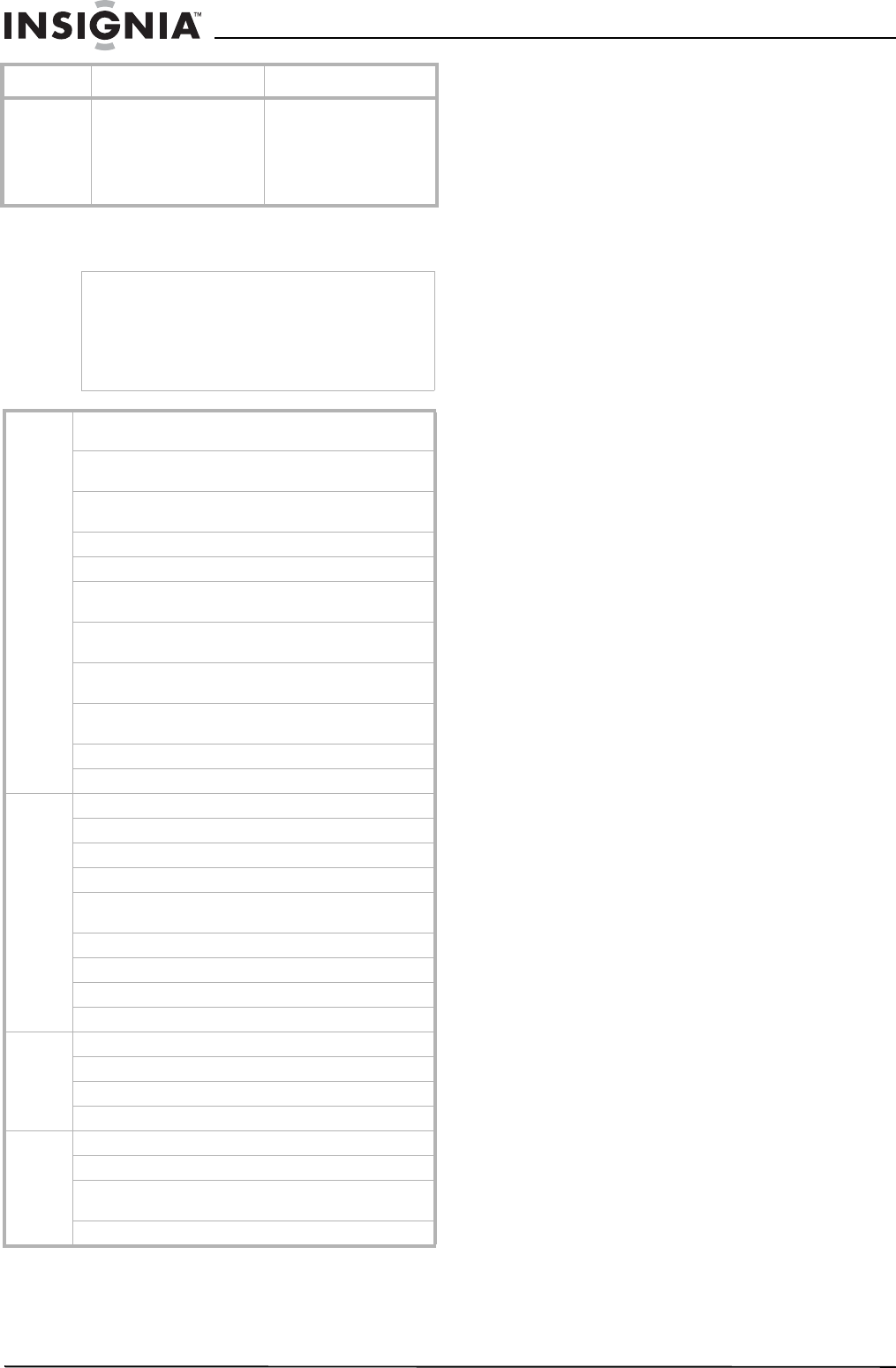
14
Insignia NS-R2000 Stereo Receiver
www.insignia-products.com
Specifications
Legal notices
FCC Part 15
This device complies with Part 15 of the FCC Rules.
Operation of this product is subject to the following two
conditions: (1) this device may not cause harmful
interference, and (2) this device must accept any interference
received, including interference that may cause undesired
operation.
This equipment has been tested and found to comply within
the limits for a class B digital device, pursuant to Part 15 of
the FCC Rules. These limits are designed to provide
reasonable protection against harmful interference in a
residential installation. This equipment generates, uses, and
can radiate radio frequency energy and, if not installed and
used in accordance with the instructions, may cause harmful
interference to radio communications. However, there is no
guarantee that interference will not occur in a particular
installation. If this equipment does cause harmful
interference to radio or television reception, which can be
determined by turning the equipment off and on, the user is
encouraged to try to correct the interference by one or more
of the following measures:
• Reorient or relocate the receiving antenna.
• Increase the separation between the equipment and
receiver.
• Connect the equipment into an outlet on a circuit
different from that to which the receiver is connected.
• Consult the dealer or an experienced technician for
help.
FCC warning
Changes or modifications not expressly approved by the
party responsible for compliance with the FCC Rules could
void the user’s authority to operate this equipment.
Canada ICES-003 statement
This Class B digital apparatus complies with Canadian
ICES-003.
Copyright
© 2007 Insignia. Insignia and the Insignia logo are
trademarks of Best Buy Enterprise Services, Inc. Other
brands and product names are trademarks or registered
trademarks of their respective holders. Specifications and
features are subject to change without notice or obligation.
For service and support call (877) 467-4289.
Remote
control unit
does not
operate.
1 Batteries are not
loaded or are
exhausted.
2 The remote
sensor is
obstructed.
1 Replace the
batteries.
2 Remove the
obstacle.
Note
• Design and specifications are subject to
change without notice.
• Weight and dimensions shown are
approximate.
• Specifications and external appearance may
be changed for the sake of improvement.
Amplifier Power output, stereo mode, 8 Ω, THD 1%,
40 Hz~20 kHz: 2×100 W
Total harmonic distortion, 8 Ω, 100 W, 40 Hz~20 kHz:
0.04%
Intermodulation distortion 60 Hz, 7 kHz= 4:1 SMPTE,
8Ω, 100 W: 0.02 %
Input sensitivity, 47 kΩ, Phono (MM): 2.5 mV
Input sensitivity, 47 kΩ, Line (CD, TAPE, AUX): 200 mV
Signal to noise ratio, IHF “A” weighted, Phono (MM):
70 dB
Signal to noise ratio, IHF “A” weighted, Line (CD, TAPE,
AUX): 95 dB
Frequency response Phono (MM), RIAA, 30 Hz~20 kHz:
8dB +/- 3dB
Frequency response Line (CD, TAPE, AUX),
20 Hz~100 kHz: 8 dB +/- 3 dB
Output level TAPE/AUX OUT, 2.2 kΩ: 200 mV
Bass/Treble control, 100 Hz/10 kHz: ±10 dB
FM Tuner Tuning frequency range: 87.5~108 MHz
Usable sensitivity, THD 3%, S/N 30 dB: 15 dBf
50 dB quieting sensitivity, mono/stereo: 25.2 / 45.2 dBf
Signal to noise ratio, 65 dBf, mono/stereo: 68/65 dB
Total harmonic distortion, 65 dBf,1 kHz, mono/stereo:
0.5 / 0.8%
Frequency response, 20 Hz~14 kHz: 8 dB +/- 3 dB
Stereo separation, 1 kHz: 40 dB
Capture ratio: 4 dB
IF rejection ratio: 80 dB
AM
Tuner
Tuning frequency range: 520~1710 kHz
Usable sensitivity: 800 µV/m
Signal to noise ratio: 40 dB
Selectivity: 25 dB
General Power supply: 120 V ~ 60 Hz
Power consumption: 2.5 A
Dimensions (W×H×D, including protruding parts):
17-3/8×5-1/2×14-3/4 inches (440×141×376 mm)
Weight (Net): 19.8 lbs (9.0 kg)
Category Problem Possible Solution


















